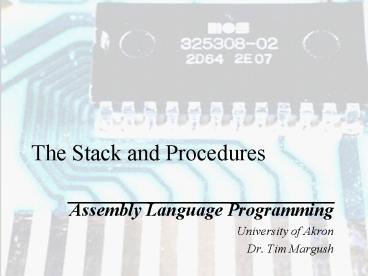The Stack and Procedures - PowerPoint PPT Presentation
1 / 20
Title:
The Stack and Procedures
Description:
RET ;to return to caller. proc_name ENDP. type is NEAR or ... Procedures may have one or more RET's. 9/28/09. Dr. Tim Margush - Assembly Language Programming ... – PowerPoint PPT presentation
Number of Views:120
Avg rating:3.0/5.0
Title: The Stack and Procedures
1
The Stack and Procedures
- Assembly Language Programming
- University of Akron
- Dr. Tim Margush
2
What Is A Stack?
- LIFO data structure
- supports PUSH and POP operations
- 8086 Architecture Stack
- Array based implementation
- Dedicated register tracks TOS
- Stack addressing modes use the BP register as an
offset into the stack - allows random access of stack contents
3
Why Have a Stack?
- The 8086 processor has stack instructions
- The processor uses the stack when interrupts
strike - Procedure calls use the stack for return
addresses - It is convenient to have one around for temporary
storage
4
Where Is The Stack?
- All executables must define a stack segment
- The stack is an array of bytes accessed via the
stack segment register and an offset - SS points to the beginning of this memory area
- SP is the offset to the top of the stack
- The loader sets these registers before execution
begins
5
Stack Initialization
- The .stack directive hides an array allocation
statement that looks like this - The_Stack DB Stack_Size dup (?)
- On program load
- SS is set to a segment address containing this
array (usually The_Stack starts at offset 0) - SP is set to the offset of The_StackStack_Size
which is one byte past the end of the stack array - This is the condition for an empty stack
6
Initial Stack Configuration
- .stack 12 Reserve space for the stack
- Loader determines actual segment address for the
start of the stack - This is an empty stack
7
How Does The Stack Work?
- The stack grows backwards through memory towards
the start of the stack segment - Push decrements stack pointerPop increments
stack pointer
8
PUSH
- PUSH source
- source is (almost) any 16/32-bit general or
segment register or the address of a word or
doubleword - PUSHF or PUSHFD
- Pushes the FLAGS register onto the stack
- A PUSH instruction subtracts 2/4 from SP and then
stores the source data at SSSP
9
PUSH Illustration
- PUSH AX
AX 0123
3C
09
A4
40
2C
FF
A2
23
2A
09
46
01
06
4C
SP0006
SS0340
10
POP
- POP destination
- destination is (almost) any 16/32-bit general or
segment register or the address of a word or
doubleword - POPF or POPFD
- Pops the top of stack to the FLAGS register
- A POP instruction copies the data at SSSP to
destination, then adds 2/4 to SP
11
POP Illustration
3C
09
A4
40
2C
FF
A2
23
2A
09
46
01
06
4C
SP0006
SS0340
- POP ES
3C
09
A4
40
2C
FF
A2
23
2A
09
46
01
06
4C
SP0008
SS0340
ES 0123
12
Stack Over/Underflow
- The processor does not check for either illegal
condition - Programs may include code to check for stack
errors - Overflow occurs when SP is smaller than the
address of the start of the stack array - Usually this means SP is decremented past 0!
- Underflow occurs if SP gets bigger than its
starting value
13
Out Of Bounds!
Stack Size 000C
SPFFFE
SS0340
- Stack Overflow
- Stack Underflow
Stack Size 000C
SP000D
SS0340
14
Procedures
- proc_name PROC type
- procedure body
- RET to return to caller
- proc_name ENDP
- type is NEAR or FAR
- the default is NEAR (small model)
- Procedures may have one or more RET's
15
Procedure Calls and Returns
- Invoke a procedure (NEAR)
- CALL proc_name
- push IP onto stack
- copy address of proc_name into IP
- Return from a procedure (NEAR)
- RET n
- pop top of stack into IP
- add n to SP (this is optional)
16
Far Procedures
- Invoke a procedure (FAR)
- CALL proc_name
- push CS, then IP onto stack
- copy far address of proc_name into CSIP
- Return from a procedure (FAR)
- RET n
- pop top of stack into IP then pop into CS
- add n to SP (this is optional)
17
Inter-Procedure Communication
- Shared storage
- The data segment is accessible to all procedures
in the current program - Registers
- Load registers with arguments (or argument
addresses) - Store return values in registers
- Place argument information on the stack
18
Interrupts
- Interrupts are special procedure calls
- These are always FAR calls since the interrupt
routines are probably not accessible from your
code segment - The Flags register must be preserved
- INT interrupt_type
- Flags register is pushed, then TF and IF are
cleared - CS is pushed, then IP is pushed
- CSIP set to address of interrupt vector implied
by interrupt_type
19
Returning From an Interrupt
- IRET
- This instruction causes the following actions
- Top of stack popped into IP
- Top of stack popped into CS
- Top of stack popped into Flags register
- This allows interrupted program to resume as if
nothing had happened
20
Homework
- Page 158
- 1-7































